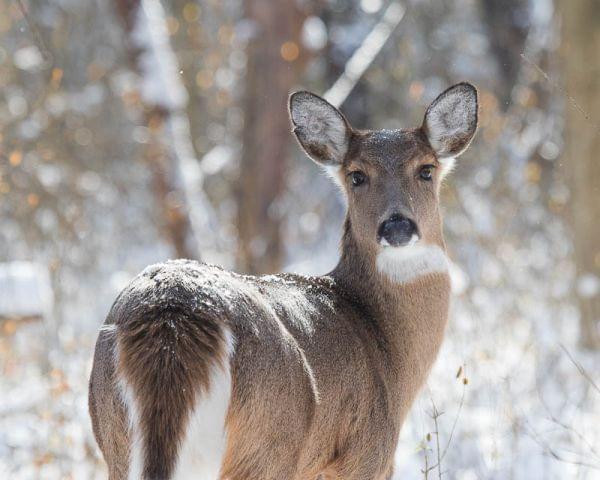Pending legislation would undermine successful deer management in Illinois

A healthy white-tailed doe in winter. Rob Kanter
If you struggle with the perception that, as a state, we too seldom get things right in Illinois, let me call your attention to the success we’ve had managing a wildlife issue that’s causing far more trouble in neighboring states, Chronic Wasting Disease.
Chronic Wasting Disease affects members of the deer, elk and moose families and was first identified among wild animals in Colorado in 1981. Since then, it and has spread widely across North America, and it was first detected in Illinois in 2002. The symptoms of the disease are gruesome—it’s like mad cow disease—and it’s fatal in every case.
In light of what was already understood about Chronic Wasting Disease, officials with the Illinois Department of Natural Resources (IDNR) and scientists from the University of Illinois, with their long history of collaboration, were poised to develop and implement a strategy for keeping the it in check in the very early days of the outbreak. That strategy, which remains in place today, combines liberalized hunting regulations with significant culling of affected herds by sharpshooters when hot spots of infected deer are found.
Officials measure the success of this strategy according to the prevalence of Chronic Wasting Disease among deer tested for it, which has remained between about one and two percent in Illinois since it arrived. That’s phenomenally low. For comparison, the prevalence of Chronic Wasting Disease among tested deer in Wisconsin, where management efforts were suspended in 2006, has now risen to approximately 30 percent.
I’d like to be able to end this commentary right here, as a feel-good story, but I can’t. That’s because the Illinois legislature is currently considering a bill that would undermine the effective management of Chronic Wasting Disease by the Department of Natural Resources by creating conditions that would promote the transmission of diseases among wild deer.
The bill would amend the state Wildlife Code to allow supplemental feeding of wild deer with items that are now prohibited outside of deer hunting season. Paul Shelton, Wildlife Program Section Head at IDNR, has already addressed the legislature opposing the bill.
And his agency’s opposition to it is supported by experts from the University of Illinois, experts who helped shape the state’s successful management strategy and who continue to monitor its effectiveness. Most notable among these are Dr. Nohra Mateus-Pinilla, who is a veterinary epidemiologist and director of the Veterinary Epidemiology Lab at the Illinois Natural History Survey, and Dr. Jan Novakofski, Associate Vice Chancellor for Research Compliance and professor in the College of ACES.
Their research group was working on Chronic Wasting Disease before the first case in the state in 2002, and, since then, they have published more than 25 peer-reviewed scientific papers concerning the disease, deer biology and principles of nutrition, growth and development in animals.
Novakofski emphasizes that, for starters, there’s no evidence of a need for supplemental feeding, and there’s no proof supplemental feed improves health, growth, or reproduction in wild deer. More importantly, both researchers hope the public and legislators will understand the potential for supplemental feeding stations to serve as hotspots for the transmission of disease.
What happens when you do this? Illinois doesn’t have to run its own experiment to find out; Wisconsin has already done it before us. The results there are high rates of Chronic Wasting Disease among deer, and low rates of satisfaction among people who value wildlife.

